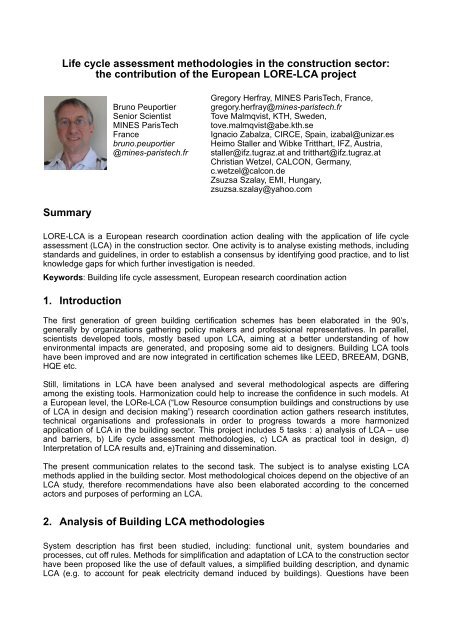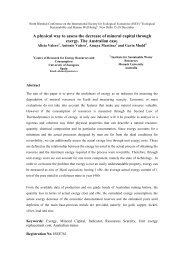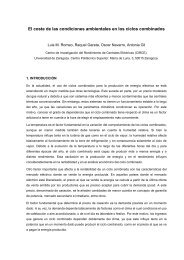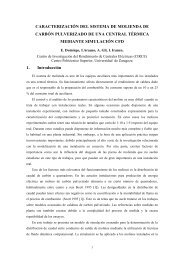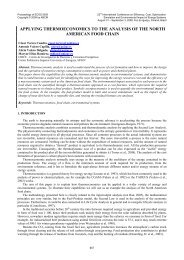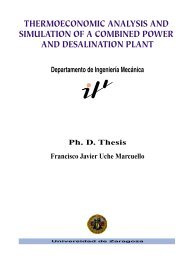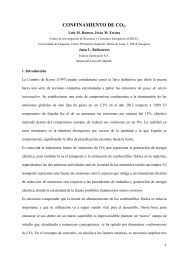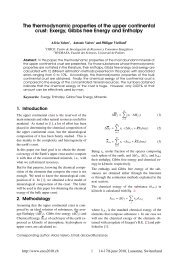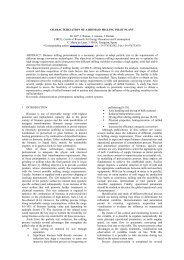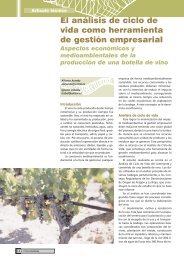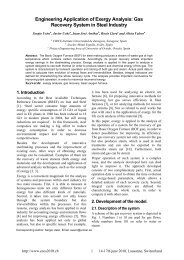Life cycle assessment methodologies in the construction sector - circe
Life cycle assessment methodologies in the construction sector - circe
Life cycle assessment methodologies in the construction sector - circe
You also want an ePaper? Increase the reach of your titles
YUMPU automatically turns print PDFs into web optimized ePapers that Google loves.
<strong>Life</strong> <strong>cycle</strong> <strong>assessment</strong> <strong>methodologies</strong> <strong>in</strong> <strong>the</strong> <strong>construction</strong> <strong>sector</strong>:<br />
<strong>the</strong> contribution of <strong>the</strong> European LORE-LCA project<br />
Summary<br />
Bruno Peuportier<br />
Senior Scientist<br />
MINES ParisTech<br />
France<br />
bruno.peuportier<br />
@m<strong>in</strong>es-paristech.fr<br />
Gregory Herfray, MINES ParisTech, France,<br />
gregory.herfray@m<strong>in</strong>es-paristech.fr<br />
Tove Malmqvist, KTH, Sweden,<br />
tove.malmqvist@abe.kth.se<br />
Ignacio Zabalza, CIRCE, Spa<strong>in</strong>, izabal@unizar.es<br />
Heimo Staller and Wibke Tritthart, IFZ, Austria,<br />
staller@ifz.tugraz.at and tritthart@ifz.tugraz.at<br />
Christian Wetzel, CALCON, Germany,<br />
c.wetzel@calcon.de<br />
Zsuzsa Szalay, EMI, Hungary,<br />
zsuzsa.szalay@yahoo.com<br />
LORE-LCA is a European research coord<strong>in</strong>ation action deal<strong>in</strong>g with <strong>the</strong> application of life <strong>cycle</strong><br />
<strong>assessment</strong> (LCA) <strong>in</strong> <strong>the</strong> <strong>construction</strong> <strong>sector</strong>. One activity is to analyse exist<strong>in</strong>g methods, <strong>in</strong>clud<strong>in</strong>g<br />
standards and guidel<strong>in</strong>es, <strong>in</strong> order to establish a consensus by identify<strong>in</strong>g good practice, and to list<br />
knowledge gaps for which fur<strong>the</strong>r <strong>in</strong>vestigation is needed.<br />
Keywords: Build<strong>in</strong>g life <strong>cycle</strong> <strong>assessment</strong>, European research coord<strong>in</strong>ation action<br />
1. Introduction<br />
The first generation of green build<strong>in</strong>g certification schemes has been elaborated <strong>in</strong> <strong>the</strong> 90’s,<br />
generally by organizations ga<strong>the</strong>r<strong>in</strong>g policy makers and professional representatives. In parallel,<br />
scientists developed tools, mostly based upon LCA, aim<strong>in</strong>g at a better understand<strong>in</strong>g of how<br />
environmental impacts are generated, and propos<strong>in</strong>g some aid to designers. Build<strong>in</strong>g LCA tools<br />
have been improved and are now <strong>in</strong>tegrated <strong>in</strong> certification schemes like LEED, BREEAM, DGNB,<br />
HQE etc.<br />
Still, limitations <strong>in</strong> LCA have been analysed and several methodological aspects are differ<strong>in</strong>g<br />
among <strong>the</strong> exist<strong>in</strong>g tools. Harmonization could help to <strong>in</strong>crease <strong>the</strong> confidence <strong>in</strong> such models. At<br />
a European level, <strong>the</strong> LORe-LCA (“Low Resource consumption build<strong>in</strong>gs and <strong>construction</strong>s by use<br />
of LCA <strong>in</strong> design and decision mak<strong>in</strong>g”) research coord<strong>in</strong>ation action ga<strong>the</strong>rs research <strong>in</strong>stitutes,<br />
technical organisations and professionals <strong>in</strong> order to progress towards a more harmonized<br />
application of LCA <strong>in</strong> <strong>the</strong> build<strong>in</strong>g <strong>sector</strong>. This project <strong>in</strong>cludes 5 tasks : a) analysis of LCA – use<br />
and barriers, b) <strong>Life</strong> <strong>cycle</strong> <strong>assessment</strong> <strong>methodologies</strong>, c) LCA as practical tool <strong>in</strong> design, d)<br />
Interpretation of LCA results and, e)Tra<strong>in</strong><strong>in</strong>g and dissem<strong>in</strong>ation.<br />
The present communication relates to <strong>the</strong> second task. The subject is to analyse exist<strong>in</strong>g LCA<br />
methods applied <strong>in</strong> <strong>the</strong> build<strong>in</strong>g <strong>sector</strong>. Most methodological choices depend on <strong>the</strong> objective of an<br />
LCA study, <strong>the</strong>refore recommendations have also been elaborated accord<strong>in</strong>g to <strong>the</strong> concerned<br />
actors and purposes of perform<strong>in</strong>g an LCA.<br />
2. Analysis of Build<strong>in</strong>g LCA <strong>methodologies</strong><br />
System description has first been studied, <strong>in</strong>clud<strong>in</strong>g: functional unit, system boundaries and<br />
processes, cut off rules. Methods for simplification and adaptation of LCA to <strong>the</strong> <strong>construction</strong> <strong>sector</strong><br />
have been proposed like <strong>the</strong> use of default values, a simplified build<strong>in</strong>g description, and dynamic<br />
LCA (e.g. to account for peak electricity demand <strong>in</strong>duced by build<strong>in</strong>gs). Questions have been
exam<strong>in</strong>ed regard<strong>in</strong>g <strong>the</strong> elaboration of life <strong>cycle</strong> <strong>in</strong>ventories, and particularly <strong>the</strong> m<strong>in</strong>imal list of<br />
substances needed for a proper impact <strong>assessment</strong>, account<strong>in</strong>g for <strong>in</strong>door emissions, data quality,<br />
and <strong>the</strong> use of European, national or local data. Specific methodological aspects have <strong>the</strong>n been<br />
addressed concern<strong>in</strong>g how to model biogenic CO2 (e.g. carbon balance of timber elements), coproducts,<br />
end of life scenarios and recycl<strong>in</strong>g. The def<strong>in</strong>ition of environmental <strong>in</strong>dicators, particularly<br />
regard<strong>in</strong>g resources, has f<strong>in</strong>ally been exam<strong>in</strong>ed as well as normalisation.<br />
The different aspects listed above show that research is still needed <strong>in</strong> order to progress towards a<br />
consensus and harmonization of different approaches.<br />
3. Elaboration of recommendations for different actors<br />
3.1 Tool developers<br />
It is first advised to <strong>in</strong>tegrate exist<strong>in</strong>g knowledge like ISO standards on LCA, future CEN standards<br />
regard<strong>in</strong>g applications <strong>in</strong> <strong>the</strong> build<strong>in</strong>g <strong>sector</strong>, guides elaborated by <strong>the</strong> International Reference <strong>Life</strong><br />
Cycle Data System (ILCD), European projects and literature.<br />
Adapt<strong>in</strong>g <strong>the</strong> tools to professional practice may lead to give <strong>the</strong> choice between us<strong>in</strong>g default and<br />
generic (or average) life <strong>cycle</strong> <strong>in</strong>ventories at early design phases, <strong>the</strong>n more specific EPDs to<br />
compare products dur<strong>in</strong>g detailed design. Interpretation is probably one of <strong>the</strong> steps requir<strong>in</strong>g <strong>the</strong><br />
most expertise. Sensitivity studies are also needed to check <strong>the</strong> robustness of <strong>the</strong> results <strong>in</strong> terms<br />
of assumptions (e.g. life span, modell<strong>in</strong>g choices etc.). For validation purposes, it is suggested to<br />
perform <strong>the</strong> benchmark study elaborated <strong>in</strong> <strong>the</strong> frame of <strong>the</strong> European <strong>the</strong>matic network PRESCO<br />
(Practical Recommendations for Susta<strong>in</strong>able Construction).<br />
3.2 Recommendations to users<br />
The ma<strong>in</strong> application of LCA <strong>in</strong> <strong>the</strong> build<strong>in</strong>g <strong>sector</strong> is related to <strong>the</strong> design phase, allow<strong>in</strong>g various<br />
architectural and/or technical choices to be compared by design teams. But LCA can also be<br />
applied <strong>in</strong> earlier phases, e.g. to compare different possible build<strong>in</strong>g sites, or to select a project <strong>in</strong><br />
<strong>the</strong> frame of an architectural competition. Elaborat<strong>in</strong>g a programme before <strong>the</strong> competition,<br />
<strong>in</strong>clud<strong>in</strong>g environmental targets, can also benefit from LCA, which may even be used for policy<br />
mak<strong>in</strong>g. LCA can also be used as urban design aid, e.g. to compare different street and build<strong>in</strong>g<br />
orientation, compactness, number of storeys etc. LCA is as well used by manufacturers <strong>in</strong> order to<br />
elaborate data on build<strong>in</strong>g products <strong>in</strong> <strong>the</strong> form of ISO-type III environmental declarations. Some<br />
work is performed to harmonize <strong>the</strong> application of LCA <strong>in</strong> <strong>the</strong> build<strong>in</strong>g and <strong>in</strong>frastructure <strong>sector</strong>s,<br />
allow<strong>in</strong>g e.g. <strong>the</strong> urban level to be addressed.<br />
4. Conclusions and perspectives<br />
Account<strong>in</strong>g for environmental issues <strong>in</strong> <strong>the</strong> build<strong>in</strong>g and urban <strong>sector</strong>s is presently based upon<br />
ra<strong>the</strong>r subjective approaches. Yet <strong>the</strong> severity and planetary extent, long duration and possible<br />
irreversibility of environmental impacts like global warm<strong>in</strong>g, nuclear risk, dispersion of toxic<br />
substances, biodiversity loss and resource depletion, justifies more precise tools to be used <strong>in</strong> <strong>the</strong><br />
decision mak<strong>in</strong>g process. LCA is presently <strong>the</strong> method <strong>in</strong>corporat<strong>in</strong>g <strong>the</strong> most knowledge, and is<br />
<strong>in</strong>creas<strong>in</strong>gly considered <strong>in</strong> e.g. labell<strong>in</strong>g or certification schemes. Knowledge gaps have still been<br />
identified and harmonization work is needed regard<strong>in</strong>g some methodological aspects like modell<strong>in</strong>g<br />
recycl<strong>in</strong>g and biogenic CO2. The LORE-LCA guidel<strong>in</strong>es report is circulated among Build<strong>in</strong>g LCA<br />
experts <strong>in</strong> order to get feedback regard<strong>in</strong>g <strong>the</strong> identification of good practice and recommendations<br />
to users and tool developers. Improv<strong>in</strong>g LCA tools and apply<strong>in</strong>g <strong>the</strong>m <strong>in</strong> decision mak<strong>in</strong>g would<br />
help build<strong>in</strong>g actors to contribute <strong>in</strong> <strong>the</strong> reduction of environmental impacts <strong>in</strong> this <strong>sector</strong>, with a<br />
possible extension to urban scale.
<strong>Life</strong> <strong>cycle</strong> <strong>assessment</strong> <strong>methodologies</strong> <strong>in</strong> <strong>the</strong> <strong>construction</strong> <strong>sector</strong>:<br />
<strong>the</strong> contribution of <strong>the</strong> European LORE-LCA project<br />
Summary<br />
Bruno Peuportier<br />
Senior Scientist<br />
MINES ParisTech<br />
France<br />
bruno.peuportier<br />
@m<strong>in</strong>es-paristech.fr<br />
Gregory Herfray, MINES ParisTech, France,<br />
gregory.herfray@m<strong>in</strong>es-paristech.fr<br />
Tove Malmqvist, KTH, Sweden,<br />
tove.malmqvist@abe.kth.se<br />
Ignacio Zabalza, CIRCE, Spa<strong>in</strong>, izabal@unizar.es<br />
Heimo Staller and Wibke Tritthart, IFZ, Austria,<br />
staller@ifz.tugraz.at and tritthart@ifz.tugraz.at<br />
Christian Wetzel, CALCON, Germany,<br />
c.wetzel@calcon.de<br />
Zsuzsa Szalay, EMI, Hungary,<br />
zsuzsa.szalay@yahoo.com<br />
LORE-LCA is a European research coord<strong>in</strong>ation action deal<strong>in</strong>g with <strong>the</strong> application of life <strong>cycle</strong><br />
<strong>assessment</strong> (LCA) <strong>in</strong> <strong>the</strong> <strong>construction</strong> <strong>sector</strong>. One activity is to analyse exist<strong>in</strong>g methods, <strong>in</strong>clud<strong>in</strong>g<br />
standards and guidel<strong>in</strong>es, <strong>in</strong> order to establish a consensus by identify<strong>in</strong>g good practice, and to list<br />
knowledge gaps for which fur<strong>the</strong>r <strong>in</strong>vestigation is needed.<br />
System description has first been studied, <strong>in</strong>clud<strong>in</strong>g: functional unit, system boundaries and<br />
processes, cut off rules. Methods for simplification and adaptation of LCA to <strong>the</strong> <strong>construction</strong> <strong>sector</strong><br />
have been proposed like <strong>the</strong> use of default values, a simplified build<strong>in</strong>g description, and dynamic<br />
LCA (e.g. to account for peak electricity demand <strong>in</strong>duced by build<strong>in</strong>gs). Questions have been<br />
exam<strong>in</strong>ed regard<strong>in</strong>g <strong>the</strong> elaboration of life <strong>cycle</strong> <strong>in</strong>ventories, and particularly <strong>the</strong> m<strong>in</strong>imal list of<br />
substances needed for a proper impact <strong>assessment</strong>, account<strong>in</strong>g for <strong>in</strong>door emissions, data quality,<br />
and <strong>the</strong> use of European, national or local data. Specific methodological aspects have <strong>the</strong>n been<br />
addressed concern<strong>in</strong>g how to model biogenic CO2 (e.g. carbon balance of timber elements), coproducts,<br />
end of life scenarios and recycl<strong>in</strong>g. The def<strong>in</strong>ition of environmental <strong>in</strong>dicators, particularly<br />
regard<strong>in</strong>g resources, has f<strong>in</strong>ally been exam<strong>in</strong>ed.<br />
Keywords: Build<strong>in</strong>g life <strong>cycle</strong> <strong>assessment</strong>, European research coord<strong>in</strong>ation action<br />
5. Introduction<br />
The first generation of green build<strong>in</strong>g certification schemes has been elaborated <strong>in</strong> <strong>the</strong> 90’s,<br />
generally by organizations ga<strong>the</strong>r<strong>in</strong>g policy makers and professional representatives. In parallel,<br />
scientists developed tools, mostly based upon LCA, aim<strong>in</strong>g at a better understand<strong>in</strong>g of how<br />
environmental impacts are generated, and propos<strong>in</strong>g some aid to designers. Build<strong>in</strong>g LCA tools<br />
have been improved and are now <strong>in</strong>tegrated <strong>in</strong> certification schemes like LEED, BREEAM, DGNB,<br />
HQE etc.<br />
Still, limitations <strong>in</strong> LCA have been analysed [3] and several methodological aspects are differ<strong>in</strong>g<br />
among <strong>the</strong> exist<strong>in</strong>g tools [11]. Harmonization could help to <strong>in</strong>crease <strong>the</strong> confidence <strong>in</strong> such models.<br />
At a European level, <strong>the</strong> LORe-LCA (“Low Resource consumption build<strong>in</strong>gs and <strong>construction</strong>s by<br />
use of LCA <strong>in</strong> design and decision mak<strong>in</strong>g”) research coord<strong>in</strong>ation action ga<strong>the</strong>rs research<br />
<strong>in</strong>stitutes, technical organisations and professionals <strong>in</strong> order to progress towards a more<br />
harmonized application of LCA <strong>in</strong> <strong>the</strong> build<strong>in</strong>g <strong>sector</strong>. This project <strong>in</strong>cludes 5 tasks :<br />
• analysis of LCA – use and barriers<br />
• <strong>Life</strong> <strong>cycle</strong> <strong>assessment</strong> <strong>methodologies</strong><br />
• LCA as practical tool <strong>in</strong> design<br />
• Interpretation of LCA results<br />
• Tra<strong>in</strong><strong>in</strong>g and dissem<strong>in</strong>ation
The present communication relates to <strong>the</strong> second task. The subject is to analyse exist<strong>in</strong>g methods,<br />
<strong>in</strong>clud<strong>in</strong>g standards and guidel<strong>in</strong>es, <strong>in</strong> order to establish a consensus by identify<strong>in</strong>g good practice,<br />
to derive recommendation for tool developers and users, and to list knowledge gaps for which<br />
fur<strong>the</strong>r <strong>in</strong>vestigation is needed. Most methodological choices depend on <strong>the</strong> objective of an LCA<br />
study, <strong>the</strong>refore recommendations have been elaborated accord<strong>in</strong>g to <strong>the</strong> concerned actors and<br />
purposes of perform<strong>in</strong>g an LCA.<br />
6. Analysis of Build<strong>in</strong>g LCA <strong>methodologies</strong><br />
6.1 System description<br />
The functional unit commonly <strong>in</strong>cludes <strong>in</strong>formation regard<strong>in</strong>g a quantity (e.g. build<strong>in</strong>g designed for<br />
90 residents), a function (e.g. provid<strong>in</strong>g space for liv<strong>in</strong>g and/or work<strong>in</strong>g <strong>in</strong> a specific location), <strong>the</strong><br />
quality of this function (comfort level, quality of life), and a duration (e.g. 80 years). Compar<strong>in</strong>g<br />
different build<strong>in</strong>gs (for <strong>in</strong>stance <strong>in</strong> an architectural competition) requires that at least <strong>the</strong> major<br />
functional requirements, <strong>in</strong>tended use and relevant specific technical requirements are well<br />
described, <strong>in</strong> order to enable transparent comparison. If build<strong>in</strong>gs of different size or life span are<br />
compared (e.g. benchmark with reference and best practice values), a reference flow can be used,<br />
e.g. 1 m 2 of residential build<strong>in</strong>g dur<strong>in</strong>g one year, or provid<strong>in</strong>g 1 person with dwell<strong>in</strong>g dur<strong>in</strong>g one<br />
year.<br />
Four stages are usually considered <strong>in</strong> <strong>the</strong> life <strong>cycle</strong> of a build<strong>in</strong>g:<br />
Production: Supply of raw materials, transport needs and manufactur<strong>in</strong>g processes from cradle to<br />
gate for <strong>the</strong> <strong>construction</strong> products, energy systems, etc.<br />
Construction: Transport of <strong>the</strong> <strong>construction</strong> products and energy systems from <strong>the</strong> manufactur<strong>in</strong>g<br />
plant to <strong>the</strong> build<strong>in</strong>g site, transport and energy demand of <strong>the</strong> <strong>construction</strong> equipment and wastes<br />
of <strong>the</strong> <strong>construction</strong> process.<br />
Use: Operational energy use for heat<strong>in</strong>g, cool<strong>in</strong>g, DHW and light<strong>in</strong>g, contribution of <strong>the</strong> renewable<br />
energy systems, operational water use, ma<strong>in</strong>tenance, repair and replacement, etc.<br />
End of life: Demolition of <strong>the</strong> build<strong>in</strong>g and disposal of each build<strong>in</strong>g product, possibly recycl<strong>in</strong>g.<br />
The system is <strong>the</strong>refore larger than <strong>the</strong> studied build<strong>in</strong>g: it <strong>in</strong>cludes <strong>the</strong> fabrication and transport of<br />
build<strong>in</strong>g products, water, electricity and heat, waste treatment etc. This is necessary <strong>in</strong> order to<br />
avoid problem shift<strong>in</strong>g, e.g. replac<strong>in</strong>g local emissions <strong>in</strong> a boiler by impacts related to electricity<br />
production.<br />
In pr<strong>in</strong>ciple, when perform<strong>in</strong>g LCA calculations, all build<strong>in</strong>g components and <strong>the</strong>ir impacts that<br />
occur with<strong>in</strong> <strong>the</strong> build<strong>in</strong>g or with<strong>in</strong> <strong>the</strong> selected scope need to be taken <strong>in</strong>to consideration. However,<br />
<strong>in</strong> practice, it can be observed that not all <strong>the</strong> material flows of a build<strong>in</strong>g can be covered <strong>in</strong> an LCA<br />
because of <strong>in</strong>sufficient time or <strong>in</strong>complete data. Cut off rules have <strong>the</strong>refore been def<strong>in</strong>ed, but<br />
research could be performed <strong>in</strong> order to establish a system to identify <strong>the</strong> <strong>in</strong>fluent material flows <strong>in</strong><br />
a particular build<strong>in</strong>g, enabl<strong>in</strong>g to justify adequate cut off rules.<br />
A similar approach can be conducted for roads, and a system description has been proposed.<br />
6.2 Study of simplification and adaptation of LCA applied to build<strong>in</strong>gs<br />
A comprehensive LCA study requires a large amount of data. It can be performed for an <strong>in</strong>dustrial<br />
product which is fabricated <strong>in</strong> large series, but it is not compatible with professional practice <strong>in</strong> <strong>the</strong><br />
build<strong>in</strong>g <strong>sector</strong>: most build<strong>in</strong>gs are unique and a lot of evaluations have to be performed dur<strong>in</strong>g <strong>the</strong><br />
design phase, <strong>the</strong>refore only a limited time can be dedicated to LCA, which imposes to simplify <strong>the</strong><br />
process.<br />
Simplified LCA tools have been developed as spreadsheets. L<strong>in</strong>k<strong>in</strong>g LCA to a CAD system,<br />
allow<strong>in</strong>g geometrical data to be used and material quantities to be automatically evaluated is<br />
helpful, as well as l<strong>in</strong>k<strong>in</strong>g LCA to e.g. energy calculations. Simplified tools focus on heavy structural<br />
elements, but some components may <strong>in</strong>duce non negligible impacts even if <strong>the</strong>y are present <strong>in</strong>
small quantities (e.g. pa<strong>in</strong>t<strong>in</strong>g). The relative contribution of a material <strong>in</strong> <strong>the</strong> global environmental<br />
impact of a build<strong>in</strong>g depends on <strong>the</strong> selected <strong>in</strong>dicators: an element may have a negligible impact<br />
on e.g. CO2 and waste <strong>in</strong>dicators, but a high contribution regard<strong>in</strong>g toxicity. Simplification of LCI<br />
data and build<strong>in</strong>g description <strong>the</strong>refore requires a careful sensitivity study, depend<strong>in</strong>g also on <strong>the</strong><br />
objective of <strong>the</strong> LCA study [9]. It is <strong>the</strong>refore recommended to cont<strong>in</strong>ue some research activities on<br />
this topic.<br />
In an early design phase, some data is still miss<strong>in</strong>g, though LCA is very useful at this moment<br />
when <strong>the</strong> decisions made <strong>in</strong>fluence most <strong>the</strong> environmental balance of a build<strong>in</strong>g. LCA is more<br />
precise at <strong>the</strong> end of <strong>the</strong> design phase, when detailed <strong>in</strong>formation is available regard<strong>in</strong>g <strong>the</strong><br />
components, producers, transport distances etc. But it is less useful because all decisions have<br />
already been made. A solution to allow LCA to be performed at early design phase is <strong>the</strong> use of<br />
default values. For <strong>in</strong>stance a default wall composition and glaz<strong>in</strong>g characteristics can be<br />
considered when study<strong>in</strong>g <strong>the</strong> architectural shape of <strong>the</strong> build<strong>in</strong>g. Def<strong>in</strong><strong>in</strong>g such default values is<br />
still to be done, though it is not really a research activity but requires ra<strong>the</strong>r a collective<br />
development by <strong>the</strong> concerned actors.<br />
Most build<strong>in</strong>g LCA tools neglect temporal variation of LCI data. For processes like electricity<br />
production, impacts may vary a lot due to seasonal, weekly and hourly peak demand. High w<strong>in</strong>ter<br />
consumption for space heat<strong>in</strong>g (e.g. heat pump) and a summer production (e.g. photovoltaic<br />
system) may not be equivalent to a low electricity consumption (e.g. gas boiler) and no production.<br />
Research is needed to progress on this aspect, which is also related to <strong>the</strong> choice between<br />
attributional or consequential LCA [4]. The attributional approach assumes that <strong>the</strong> studied system<br />
(e.g. a build<strong>in</strong>g) has a negligible effect on <strong>the</strong> background system (e.g. electricity production). But if<br />
e.g. 75% of <strong>the</strong> new build<strong>in</strong>gs are heated by electricity <strong>in</strong> a country, this has globally an impact on<br />
<strong>the</strong> electricity production mix so that <strong>the</strong> consequential approach may be preferred. But this<br />
approach is much more complex and would require additional knowledge.<br />
6.3 Study of life <strong>cycle</strong> <strong>in</strong>ventories<br />
Many producers of build<strong>in</strong>g components are SMEs, and cannot easily commission a specialised<br />
consultant to perform a detailed LCA. Impos<strong>in</strong>g a very detailed format for life <strong>cycle</strong> <strong>in</strong>ventories (LCI)<br />
would not permit to get data for most low impact materials which are ma<strong>in</strong>ly produced by small<br />
companies, so that data would only be available for standard materials. On <strong>the</strong> o<strong>the</strong>r hand, too<br />
simplistic LCI data would not allow issues like toxicity and biodiversity to be evaluated. At <strong>the</strong><br />
moment, <strong>the</strong> number of substances provided <strong>in</strong> LCIs varies between around 10 et around 1,000.<br />
This is to be compared with <strong>the</strong> estimated 100,000 substances available on <strong>the</strong> market.<br />
Ano<strong>the</strong>r simplification <strong>in</strong> LCI data is spatial averag<strong>in</strong>g of emissions. In fact, a substance emitted<br />
<strong>in</strong>side a build<strong>in</strong>g may have more impact (particularly on health) than an outdoor emission, which is<br />
much more diluted and causes less exposure because we spend around 90% of our time <strong>in</strong>door.<br />
But modell<strong>in</strong>g <strong>the</strong> time vary<strong>in</strong>g <strong>in</strong>door emissions, dilution accord<strong>in</strong>g to air movements, occupants’<br />
exposure and health risk is still a research topic, though a method is proposed [7]. Measur<strong>in</strong>g<br />
<strong>in</strong>door release of substances is also difficult due to temporal variation, substance characteristics<br />
and relationship with ventilation and air <strong>in</strong>filtration.<br />
Local data is still miss<strong>in</strong>g <strong>in</strong> most countries, so that foreign LCI data is frequently used. But <strong>in</strong> this<br />
case, adaptation is needed accord<strong>in</strong>g to possible differences on e.g. <strong>the</strong> electricity production mix,<br />
transport distance, orig<strong>in</strong> of raw materials, waste treatment processes etc. Such data process<strong>in</strong>g is<br />
called “contextualization”. Adapt<strong>in</strong>g impact <strong>assessment</strong> to a local context is still a research topic.<br />
6.4 Study of specific methodological aspects<br />
There is at <strong>the</strong> moment no consensus on how to account for e.g. biogenic CO2 <strong>in</strong> LCA, as well as<br />
allocation methods for co-products, modell<strong>in</strong>g of recycl<strong>in</strong>g, elaboration of end of life scenarios for<br />
different types of <strong>construction</strong>/renovation/demolition waste. Such aspects are be<strong>in</strong>g discussed<br />
among <strong>the</strong> LCA community, and have implications <strong>in</strong> <strong>the</strong> build<strong>in</strong>g <strong>sector</strong>.
Plants convert carbon dioxide from air <strong>in</strong>to cellulose and o<strong>the</strong>r substances by us<strong>in</strong>g direct sunlight<br />
(photosyn<strong>the</strong>sis), reduc<strong>in</strong>g <strong>the</strong> CO2 content of <strong>the</strong> atmosphere and hence to contribut<strong>in</strong>g to climate<br />
change mitigation. The phenomena occurr<strong>in</strong>g <strong>in</strong> forests and <strong>the</strong> complex production processes<br />
associated to timber products have been analysed <strong>in</strong> several studies. Two ma<strong>in</strong> approaches exist:<br />
some authors do not account for biogenic CO2, argu<strong>in</strong>g that <strong>the</strong> CO2 absorbed dur<strong>in</strong>g<br />
photosyn<strong>the</strong>sis will sooner or later be released back <strong>in</strong>to <strong>the</strong> atmosphere. O<strong>the</strong>r models account<br />
for a negative CO2 emission at <strong>the</strong> production stage and a release at <strong>the</strong> end of life depend<strong>in</strong>g on<br />
<strong>the</strong> process (landfill, <strong>in</strong>c<strong>in</strong>eration with or without heat recovery, re-use etc.). A method is proposed<br />
<strong>in</strong> <strong>the</strong> International Reference <strong>Life</strong> Cycle Data System (ILCD) handbook [2] <strong>in</strong> order to account for<br />
CO2 storage dur<strong>in</strong>g <strong>the</strong> life span of <strong>the</strong> material <strong>in</strong> a build<strong>in</strong>g: if x tons of CO2 are stored dur<strong>in</strong>g n<br />
years <strong>in</strong> a build<strong>in</strong>g, <strong>the</strong> accounted negative CO2 emission is n% of x (GWP100 be<strong>in</strong>g evaluated,<br />
emissions or storage beyond 100 years are considered separately). Some authors account<br />
negative CO2 emissions only for timber from certified forest (e.g. Forest Stewardship Council).<br />
Several approaches are also possible to model co-products. The total impacts of <strong>the</strong> process can<br />
be evaluated, but <strong>the</strong>ir allocation can be done accord<strong>in</strong>g to <strong>the</strong> mass of each co-product, or <strong>the</strong>ir<br />
value, or <strong>the</strong> system is expanded (which is recommended by ILCD). For <strong>in</strong>stance, <strong>in</strong> <strong>the</strong> case of<br />
waste <strong>in</strong>c<strong>in</strong>eration with energy recovery, <strong>the</strong> process is used for waste treatment, heat and possibly<br />
electricity production. Allocation is needed to evaluate <strong>the</strong> impacts for each of <strong>the</strong>se services,<br />
which is useful for <strong>in</strong>stance to perform an LCA of a build<strong>in</strong>g heated by such a source.<br />
End of life is probably one of <strong>the</strong> most difficult stage to model, due to <strong>the</strong> large uncerta<strong>in</strong>ty on<br />
processes that will occur <strong>in</strong> a far future (build<strong>in</strong>gs be<strong>in</strong>g long last<strong>in</strong>g compared to most <strong>in</strong>dustrial<br />
products). One approach is to consider, by precaution, <strong>the</strong> same waste treatment processes as<br />
today. For <strong>in</strong>stance if a material is <strong>in</strong>c<strong>in</strong>erated today and not re<strong>cycle</strong>d, it may seem too optimistic to<br />
assume that technical <strong>in</strong>novation will allow this product to be re<strong>cycle</strong>d <strong>in</strong> <strong>the</strong> future. One alternative<br />
could be to use a probabilistic scenario.<br />
Recycl<strong>in</strong>g generates an impact (noted Ir), and usually a supplementary transport related impact (It)<br />
because <strong>the</strong> recycl<strong>in</strong>g facility is fur<strong>the</strong>r than e.g. landfill (o<strong>the</strong>rwise, It can be negative). On <strong>the</strong><br />
o<strong>the</strong>r hand it avoids <strong>the</strong> impacts correspond<strong>in</strong>g to new fabrication (In) and to waste treatment (Iw).<br />
Recycl<strong>in</strong>g should be promoted if <strong>the</strong> related impacts (Ir + It) are lower compared to <strong>the</strong> total impact<br />
of new production from raw materials and waste treatment (In + Iw). The “avoided impact” by<br />
recycl<strong>in</strong>g is <strong>the</strong>n : In +Iw – Ir - It. In this case, good practice consists <strong>in</strong>:<br />
- reward<strong>in</strong>g <strong>the</strong> use of re<strong>cycle</strong>d products at <strong>the</strong> <strong>construction</strong> phase,<br />
- reward<strong>in</strong>g sort<strong>in</strong>g waste and recycl<strong>in</strong>g at <strong>the</strong> end of life,<br />
- avoid<strong>in</strong>g double count<strong>in</strong>g of <strong>the</strong> benefit of recycl<strong>in</strong>g.<br />
The impact reduction depends on <strong>the</strong> recycl<strong>in</strong>g rates rf at <strong>the</strong> fabrication and re at end of life. There<br />
exist different methods to model recycl<strong>in</strong>g <strong>in</strong> build<strong>in</strong>g LCA tools. Accord<strong>in</strong>g to <strong>the</strong> stock flow method,<br />
<strong>the</strong> impact reduction is rf . (In – Ir) at <strong>the</strong> <strong>construction</strong> phase and re. (Iw – It) at <strong>the</strong> end of life.<br />
The steel <strong>in</strong>dustry proposes a reduction of rf . (In – Ir) at <strong>the</strong> <strong>construction</strong> phase, (re-rf). (In-Ir) +<br />
re.(Iw-It) at <strong>the</strong> end of life.<br />
The avoided impact method evaluates an impact reduction of rf.(In+Iw-Ir-It)/2 at fabrication and<br />
re.(In+Iw-Ir-It)/2 at end of life [12], <strong>the</strong> factor ½ be<strong>in</strong>g used to avoid double count<strong>in</strong>g. The avoided<br />
impact at <strong>the</strong> end of life is very uncerta<strong>in</strong>, on <strong>the</strong> o<strong>the</strong>r hand it allows efforts towards “design for<br />
dismantl<strong>in</strong>g” to be rewarded.<br />
There exist as well different approaches to evaluate <strong>the</strong> impact of a system regard<strong>in</strong>g resource<br />
depletion. Simply add<strong>in</strong>g material quantities does not account for <strong>the</strong> scarcity of each resource.<br />
Some <strong>in</strong>dicators are based upon <strong>the</strong> economically or technically available or ultimate reserve of<br />
each raw material or fuel. Some account also for <strong>the</strong> extraction rate (abiotic depletion potential,<br />
ADP, [6]), o<strong>the</strong>rs are based upon <strong>the</strong> marg<strong>in</strong>al <strong>in</strong>crease of cost, or <strong>the</strong> “surplus energy”<br />
(Eco<strong>in</strong>dicator 99, [5]): consum<strong>in</strong>g a resource <strong>in</strong>creases <strong>the</strong> cost or energy needed to extract this<br />
resource because <strong>the</strong> reserve need<strong>in</strong>g <strong>the</strong> lowest effort is extracted first.<br />
One common knowledge gap <strong>in</strong> ADP and Eco<strong>in</strong>dicator 99 methods concerns uranium. This substance<br />
is not <strong>in</strong>cluded <strong>in</strong> <strong>the</strong> second <strong>in</strong>dicator due to lack of data [15]. In <strong>the</strong> first <strong>in</strong>dicator, ultimate
eserves are considered and <strong>the</strong> correspond<strong>in</strong>g value is very large for uranium: 62.5 billion tons, to<br />
be compared with 13 million tonnes probable reserves given by <strong>the</strong> U.S bureau of M<strong>in</strong>es. As a<br />
result, <strong>the</strong> use of uranium has a negligible <strong>in</strong>fluence on <strong>the</strong> <strong>in</strong>dicator value. In fact, a large part of<br />
<strong>the</strong>se ultimate reserves is very much diluted so that more energy would be needed to extract usable<br />
uranium than <strong>the</strong> energy this uranium could provide. Therefore consider<strong>in</strong>g ultimate reserves<br />
does not seem relevant <strong>in</strong> this case. If probable reserves would be used <strong>in</strong>stead, <strong>the</strong> <strong>in</strong>dicator<br />
value would be much more sensitive to uranium consumption. This aspect is important <strong>in</strong> <strong>the</strong> build<strong>in</strong>g<br />
<strong>sector</strong>, which consumes around 65% of <strong>the</strong> electricity produced <strong>in</strong> Europe, with around 40%<br />
average contribution of nuclear plants. Specific research would <strong>the</strong>refore be needed to improve or<br />
complement <strong>the</strong> exist<strong>in</strong>g resource <strong>in</strong>dicators.<br />
A primary energy demand <strong>in</strong>dicator is evaluated <strong>in</strong> most of LCA tools (e.g. cumulated energy<br />
demand) and, accord<strong>in</strong>g to some guides and standards, split <strong>in</strong>to renewable and non renewable<br />
parts. But consum<strong>in</strong>g solar electricity produced <strong>in</strong> <strong>the</strong> build<strong>in</strong>g itself or renewable electricity from<br />
<strong>the</strong> grid may have different consequences on e.g. peak demand and grid management. Wood,<br />
hydro-power and geo<strong>the</strong>rmal energy is limited: consum<strong>in</strong>g wood <strong>in</strong> a build<strong>in</strong>g reduces <strong>the</strong> biomass<br />
resource for o<strong>the</strong>rs. On <strong>the</strong> o<strong>the</strong>r hand <strong>in</strong>stall<strong>in</strong>g a solar collector on a roof does not reduce <strong>the</strong><br />
resource for o<strong>the</strong>rs, so that add<strong>in</strong>g solar and biomass energy consumption might not be relevant.<br />
May be <strong>the</strong> right split is not between renewables and non renewables, but between limited and non<br />
limited energy flows. In this logic, imported biomass, hydropower, geo<strong>the</strong>rmal and w<strong>in</strong>d energy<br />
would be accounted for but solar electricity or heat produced on site would not be considered<br />
limited. O<strong>the</strong>r <strong>in</strong>dicators are related to resources (e.g. cumulative exergy demand [1], [14]), water<br />
(consider<strong>in</strong>g potable, groundwater, rivers, oceans...), and ground (possibly account<strong>in</strong>g for ground<br />
transformation).<br />
Different <strong>in</strong>dicators are also proposed for o<strong>the</strong>r environmental issues (e.g. global warm<strong>in</strong>g, toxicity,<br />
eco-toxicity) and may correspond to mid-po<strong>in</strong>t or end-po<strong>in</strong>t evaluation: for <strong>in</strong>stance a number of life<br />
loss years is an end-po<strong>in</strong>t (or damage) <strong>in</strong>dicator whereas a body weight subject to a certa<strong>in</strong> dose<br />
of pollutant is a mid-po<strong>in</strong>t <strong>in</strong>dicator. Damage <strong>in</strong>dicators require more sophisticated models [13], but<br />
correspond more to corporate social responsibility approaches. The elaboration of a<br />
comprehensive but not redundant set of <strong>in</strong>dicators is f<strong>in</strong>ally needed.<br />
Normalisation is useful to rank <strong>the</strong> contribution of a build<strong>in</strong>g on several impacts us<strong>in</strong>g <strong>the</strong> same<br />
scale, allow<strong>in</strong>g priorities for impact reduction to be identified (e.g. choos<strong>in</strong>g <strong>the</strong> highest normalized<br />
impact). Normalisation is based upon a reference value, generally per capita. This reference value<br />
could correspond to a regional, national, European or world average, accord<strong>in</strong>g to <strong>the</strong> purpose of<br />
<strong>the</strong> study. Weight<strong>in</strong>g factors are always normative/subjective, and reflect value assumptions: <strong>the</strong>y<br />
are not necessary <strong>in</strong> LCA but may be required by a client or political authority. In any case, LCIA<br />
methods, possible normalisation and weight<strong>in</strong>g, should be precisely documented so that <strong>the</strong> users<br />
have a clear knowledge of <strong>the</strong> performed evaluation.<br />
The different aspects listed above show that research is still needed <strong>in</strong> order to progress towards a<br />
consensus and harmonization of <strong>the</strong>se different approaches.<br />
7. Elaboration of recommendations for different actors<br />
7.1 Tool developers<br />
It is first advised to <strong>in</strong>tegrate exist<strong>in</strong>g knowledge like ISO standards on LCA, future CEN standards<br />
regard<strong>in</strong>g applications <strong>in</strong> <strong>the</strong> build<strong>in</strong>g <strong>sector</strong>, guides elaborated by <strong>the</strong> International Reference <strong>Life</strong><br />
Cycle Data System (ILCD, [6]), European projects and literature.<br />
Adapt<strong>in</strong>g <strong>the</strong> tools to professional practice may lead to give <strong>the</strong> choice between us<strong>in</strong>g default and<br />
generic (or average) life <strong>cycle</strong> <strong>in</strong>ventories at early design phases, <strong>the</strong>n more specific EPDs to<br />
compare products dur<strong>in</strong>g detailed design. Limits and difficulties are addressed <strong>in</strong> <strong>the</strong> LORE-LCA<br />
project regard<strong>in</strong>g <strong>the</strong> consequential LCA approach, def<strong>in</strong>ition of <strong>the</strong> functional unit, system<br />
boundaries, determ<strong>in</strong>ation of cut off rule threshold, handl<strong>in</strong>g of far future and related uncerta<strong>in</strong>
processes, perform<strong>in</strong>g sensitivity studies (e.g. regard<strong>in</strong>g <strong>the</strong> considered life span of a build<strong>in</strong>g).<br />
Interpretation is probably one of <strong>the</strong> steps requir<strong>in</strong>g <strong>the</strong> most expertise. The tools should help <strong>the</strong><br />
users identify<strong>in</strong>g <strong>the</strong> processes/materials and life <strong>cycle</strong> stages hav<strong>in</strong>g a highest contribution <strong>in</strong> <strong>the</strong><br />
global impacts, e.g. us<strong>in</strong>g bar or pie charts, and contribution analysis techniques. Sensitivity studies<br />
are also needed to check <strong>the</strong> robustness of <strong>the</strong> results <strong>in</strong> terms of assumptions (e.g. life span,<br />
modell<strong>in</strong>g choices etc.). Scenario analysis techniques can be used for this purpose. Uncerta<strong>in</strong>ty<br />
analysis (e.g. us<strong>in</strong>g Monte Carlo simulation for stochastic uncerta<strong>in</strong>ty) would be also helpful, which<br />
could constitute ano<strong>the</strong>r research topic. Identify<strong>in</strong>g limitations <strong>in</strong> <strong>the</strong> conclusions may be addressed<br />
by present<strong>in</strong>g example case studies, show<strong>in</strong>g that recommendations (e.g. design advice) can be<br />
accompanied with statements limit<strong>in</strong>g <strong>the</strong>ir scope (e.g. this recommendation is valid if <strong>the</strong> build<strong>in</strong>g<br />
life span is longer than 50 years). The risk of mis<strong>in</strong>terpretation could also be illustrated by examples<br />
(e.g. over-<strong>in</strong>terpreted comparison based upon <strong>in</strong>significant impact differences).<br />
As mentioned previously, LCA cannot be performed <strong>in</strong> <strong>the</strong> build<strong>in</strong>g <strong>sector</strong> with <strong>the</strong> same level of<br />
detail as <strong>in</strong> <strong>the</strong> <strong>in</strong>dustry. In practice, a critical review process cannot be organised e.g. for <strong>the</strong><br />
design of one build<strong>in</strong>g. May be one solution is that such a review is organised once (or once a year)<br />
for each Build<strong>in</strong>g LCA tool, <strong>in</strong> order to check <strong>the</strong> methodology, data and hypo<strong>the</strong>ses. Organis<strong>in</strong>g a<br />
users club with <strong>the</strong> possibility to cross review some studies, <strong>in</strong>ternet forums etc. could also be<br />
relevant.<br />
It is suggested to perform <strong>the</strong> benchmark study elaborated <strong>in</strong> <strong>the</strong> frame of <strong>the</strong> European <strong>the</strong>matic<br />
network PRESCO (Practical Recommendations for Susta<strong>in</strong>able Construction, see http://www.etnpresco.net/general<strong>in</strong>fo/<strong>in</strong>dex.html<br />
[10]). Two case studies are described. The first one is a simple<br />
concrete cube allow<strong>in</strong>g a first verification of <strong>the</strong> life <strong>cycle</strong> calculation <strong>in</strong> a very simple case. The<br />
second is a wooden house, also not too complex so that <strong>the</strong> risk of erroneous <strong>in</strong>put is limited.<br />
Several environmental <strong>in</strong>dicators have been calculated us<strong>in</strong>g 8 tools developed <strong>in</strong> different<br />
countries. The results can be used to compare new tools and identify possible errors.<br />
7.2 Recommendations to users<br />
The ma<strong>in</strong> application of LCA <strong>in</strong> <strong>the</strong> build<strong>in</strong>g <strong>sector</strong> is related to <strong>the</strong> design phase, allow<strong>in</strong>g various<br />
architectural and/or technical choices to be compared by design teams [16]. But LCA can also be<br />
applied <strong>in</strong> earlier phases, e.g. to compare different possible build<strong>in</strong>g sites, or to select a project <strong>in</strong><br />
<strong>the</strong> frame of an architectural competition. In such a case, us<strong>in</strong>g default values is necessary for<br />
unknown parameters, or predef<strong>in</strong>ed elements if <strong>the</strong> client has <strong>in</strong>dicated some choices (e.g.<br />
preference for wooden materials). All competitors should <strong>the</strong>n use <strong>the</strong> same data. Different<br />
simplified LCA tools exist, ei<strong>the</strong>r spreadsheets or models comb<strong>in</strong>ed with a graphical <strong>in</strong>terface,<br />
mak<strong>in</strong>g possible to evaluate several projects proposed <strong>in</strong> a competition with a reasonable effort.<br />
Projects hav<strong>in</strong>g a different area will cause a difficulty to <strong>the</strong> jury: a larger build<strong>in</strong>g could be more<br />
functional but generate more impacts, lead<strong>in</strong>g to a contradict<strong>in</strong>g evaluation.<br />
Elaborat<strong>in</strong>g a programme before <strong>the</strong> competition, <strong>in</strong>clud<strong>in</strong>g environmental targets, can also benefit<br />
from LCA, which may even be used for policy mak<strong>in</strong>g. In this case, due to <strong>the</strong> large scale of <strong>the</strong><br />
considered system, consequential LCA (CLCA) is generally more relevant than attributional LCA.<br />
This has implications on <strong>the</strong> def<strong>in</strong>ition of <strong>the</strong> system boundaries because consequences on <strong>the</strong><br />
background system have to be accounted for. CLCA is more complex, and goes beyond <strong>the</strong> limits<br />
of most present build<strong>in</strong>g LCA tools so that a large expertise is needed, e.g. to avoid double<br />
count<strong>in</strong>g of impacts, select appropriate life <strong>cycle</strong> data and def<strong>in</strong>e relevant scenarios to model <strong>the</strong><br />
complex cause and effect relationships between <strong>the</strong> studied system and <strong>the</strong> background system.<br />
LCA can also be used as urban design aid [7], e.g. to compare different street and build<strong>in</strong>g<br />
orientation, compactness, number of storeys etc. Higher use of solar energy for heat<strong>in</strong>g and<br />
light<strong>in</strong>g may reduce <strong>the</strong> compactness of build<strong>in</strong>gs, and <strong>in</strong>crease <strong>the</strong> use of materials because of a<br />
higher area of facade. A zero energy objective may lead to decrease <strong>the</strong> number of storeys, and<br />
<strong>the</strong>refore to <strong>in</strong>crease land use. Balanc<strong>in</strong>g build<strong>in</strong>g and transport related impacts may also<br />
constitute promis<strong>in</strong>g applications. Target sett<strong>in</strong>g at a municipal level would also benefit of such life
<strong>cycle</strong> perspective. Like <strong>in</strong> <strong>the</strong> case of apply<strong>in</strong>g LCA for architectural competition, simplification is<br />
needed, particularly when us<strong>in</strong>g excel based tools.<br />
LCA is also used by manufacturers <strong>in</strong> order to elaborate data on build<strong>in</strong>g products <strong>in</strong> <strong>the</strong> form of<br />
ISO-type III environmental declarations. Such data is based on a LCA study follow<strong>in</strong>g <strong>the</strong> Product<br />
Category Rules (PCR), which set <strong>the</strong> specific goal and scope of <strong>the</strong> LCA and <strong>the</strong> guidel<strong>in</strong>es for<br />
develop<strong>in</strong>g EPDs for one or more product categories (prescriptions for data collection, handl<strong>in</strong>g<br />
and calculation rules). There exist presently EPD programmes <strong>in</strong> more than 10 countries. Some<br />
methodological aspects are precised <strong>in</strong> standards, e.g. system boundaries <strong>in</strong> prEN 15 804,<br />
reference service life <strong>in</strong> ISO 15686-1 and ISO 15686-8, cut off rules <strong>in</strong> ISO 21930, environmental<br />
<strong>in</strong>dicators <strong>in</strong> prEN 15804. All used data sources should be documented, specify<strong>in</strong>g clearly <strong>the</strong>ir<br />
uncerta<strong>in</strong>ty, <strong>in</strong>tegrity, representativeness (geographical, temporal, technological), coherence and<br />
reproducibility. Us<strong>in</strong>g data from different EPD programmes to compare different materials is<br />
generally not possible because <strong>the</strong> rules are def<strong>in</strong>ed nationally and <strong>the</strong>y are <strong>in</strong> general not<br />
harmonized.<br />
Some work is performed to harmonize <strong>the</strong> application of LCA <strong>in</strong> <strong>the</strong> build<strong>in</strong>g and <strong>in</strong>frastructure<br />
<strong>sector</strong>s, allow<strong>in</strong>g e.g. <strong>the</strong> urban level to be addressed. Infrastructure <strong>in</strong>cludes a number of items,<br />
such as roads, water supply, power grids, sewage systems, telecommunication, waste handl<strong>in</strong>g.<br />
Each item <strong>in</strong>volves many processes constitut<strong>in</strong>g a complex system. Various alternatives can be<br />
proposed <strong>in</strong> each <strong>sector</strong>, e.g. road, rail, air and water transport, renewable or fossil energy systems,<br />
landfill, <strong>in</strong>c<strong>in</strong>eration or recycl<strong>in</strong>g waste treatment etc. Beyond technical aspects, management<br />
aspects may be also important (smart grid, <strong>in</strong>telligent transport systems...).<br />
8. Conclusions and perspectives<br />
Account<strong>in</strong>g for environmental issues <strong>in</strong> <strong>the</strong> build<strong>in</strong>g and urban <strong>sector</strong>s is presently based upon<br />
ra<strong>the</strong>r subjective approaches. Yet <strong>the</strong> severity and planetary extent, long duration and possible<br />
irreversibility of environmental impacts like global warm<strong>in</strong>g, nuclear risk, dispersion of toxic<br />
substances, biodiversity loss and resource depletion, justifies more precise tools to be used <strong>in</strong> <strong>the</strong><br />
decision mak<strong>in</strong>g process. LCA is presently <strong>the</strong> method <strong>in</strong>corporat<strong>in</strong>g <strong>the</strong> most knowledge, and is<br />
<strong>in</strong>creas<strong>in</strong>gly considered <strong>in</strong> e.g. labell<strong>in</strong>g or certification schemes. Knowledge gaps have still been<br />
identified and harmonization work is needed regard<strong>in</strong>g some methodological aspects like modell<strong>in</strong>g<br />
recycl<strong>in</strong>g and biogenic CO2. The LORE-LCA guidel<strong>in</strong>es report is circulated among Build<strong>in</strong>g LCA<br />
experts <strong>in</strong> order to get feedback regard<strong>in</strong>g <strong>the</strong> identification of good practice and recommendations<br />
to users and tool developers. Improv<strong>in</strong>g LCA tools and apply<strong>in</strong>g <strong>the</strong>m <strong>in</strong> decision mak<strong>in</strong>g would<br />
help build<strong>in</strong>g actors to contribute <strong>in</strong> <strong>the</strong> reduction of environmental impacts <strong>in</strong> this <strong>sector</strong>, with a<br />
possible extension to urban scale.<br />
Acknowledgement<br />
This research coord<strong>in</strong>ation action LORE-LCA has been funded by <strong>the</strong> European Commission<br />
with<strong>in</strong> <strong>the</strong> 7 th Framework Programme.<br />
References<br />
[1] Dewulf, J. et al., Cumulative Exergy extraction from <strong>the</strong> natural environment (CEENE): a<br />
comprehensive <strong>Life</strong> Cycle Impact Assessment Method for resource depletion. Env. Science and<br />
Technology, 2007.<br />
[2] European Commission Jo<strong>in</strong>t Research Centre, International Reference <strong>Life</strong> Cycle Data System<br />
(ILCD), General guide for life <strong>cycle</strong> <strong>assessment</strong> –detailed guidance, March 2010, jrc.ec.europa.eu.<br />
[3] F<strong>in</strong>nveden, G., On <strong>the</strong> limitations of <strong>Life</strong> Cycle Assessment and Environmental Systems<br />
Analysis Tools <strong>in</strong> General. International Journal of LCA 5 (4), (2000) 229-238.<br />
[4] F<strong>in</strong>nveden, G., Hauschild, M., Ekvall, T., Gu<strong>in</strong>ée, J., Heijungs, R., Hellweg, S., Koehler, A.,<br />
Penn<strong>in</strong>gton, D. W. and Suh, S. Recent developments <strong>in</strong> <strong>Life</strong> Cycle Assessment. Journal of<br />
Environmental Management 91 (2009), 1–21
[5] Goedkoop M, Spriensma R. The Eco-<strong>in</strong>dicator 99: a damage oriented method for life <strong>cycle</strong><br />
impact <strong>assessment</strong>. Amersfoort: PRé Consultants. Available on l<strong>in</strong>e at, http://www.pre.nl/eco<strong>in</strong>dicator99;<br />
2000.<br />
[6] Gu<strong>in</strong>ée J. B., (f<strong>in</strong>al editor), Gorée M., Heijungs R., Huppes G., Kleijn R., de Kon<strong>in</strong>g A., van Oers<br />
L., Wegener Sleeswijk A., Suh S., Udo de Haes H. A., de Bruijn H., van Du<strong>in</strong> R., Huibregts M. A. J.,<br />
L<strong>in</strong>deijer E., Roorda A. A. H., WeidemaB. P. “<strong>Life</strong> <strong>cycle</strong> <strong>assessment</strong>; An operational guide to <strong>the</strong><br />
ISO standards”, M<strong>in</strong>istry of Hous<strong>in</strong>g, Spatial Plann<strong>in</strong>g and Environment (VROM) and Centre of<br />
Environmental Science (CML), Den Haag and Leiden, The Ne<strong>the</strong>rlands, 704 p. (2001)<br />
[7] Hellweg, S., Demou, E., Bruzzi, R., Meijer, A., Rosenbaum, R.K., Huijbregts, M.A.J., McKone,<br />
T.E., Integrat<strong>in</strong>g <strong>in</strong>door air pollutant exposure with<strong>in</strong> life <strong>cycle</strong> impact <strong>assessment</strong>. Environ. Sci.<br />
Technol. 43 (2009), 1670–1679.<br />
[8] Herfray G., Peuportier B., <strong>Life</strong> Cycle Assessment applied to urban settlements, Susta<strong>in</strong>able<br />
Build<strong>in</strong>g Conference 2010, Madrid<br />
[9] Kellenberger D, Althaus H- J. Relevance of simplifications <strong>in</strong> LCA of build<strong>in</strong>g components.<br />
Build<strong>in</strong>g and Environment;44 (2009) : 818-25<br />
[10] Peuportier B., Kellenberger D., An<strong>in</strong>k D., Mötzl H., Anderson J., Vares S., Chevalier J., and<br />
König H., Inter-comparison and benchmark<strong>in</strong>g of LCA-based environmental <strong>assessment</strong> and<br />
design tools, Susta<strong>in</strong>able Build<strong>in</strong>g 2004 Conference, Warsaw<br />
[11] Peuportier, B., Scarpell<strong>in</strong>i, S., Glaumann, M., Malmqvist, T., Krigsvol, G., Wetzel, C., Staller, H.,<br />
Szalay, S., Degiovanni, V. and Stoykova, E. (2008), ENSLIC State of <strong>the</strong> art report,<br />
http://<strong>circe</strong>.cps.unizar.es/enslic/<strong>in</strong>dex.htm<br />
[12] Polster B, Peuportier B, Blanc I, Diaz P, Gob<strong>in</strong> C, Durand E. Evaluation of <strong>the</strong> environmental<br />
quality of build<strong>in</strong>gs - a step towards a more environmentally conscious design. Solar Energy<br />
(1996) ;57(3):219-30.<br />
[13] Rosenbaum, R., Bachmann, T., Swirsky Gold, L., Huijbregts, M., Jolliet, O., Juraske, R.,<br />
Koehler, A., Larsen, H. F., MacLeod, M., Margni, M., McKone, T., Payet, J., Schuhmacher, M., van<br />
de Meent, D. and Hauschild, M., USEtox - <strong>the</strong> UNEP-SETAC toxicity model: recommended<br />
characterisation factors for human toxicity and freshwater ecotoxicity <strong>in</strong> life <strong>cycle</strong> impact<br />
<strong>assessment</strong>. International Journal of LCA 13 (2008) 532-546.<br />
[14] Szargut J. et al. Exergy analysis of <strong>the</strong>rmal, chemical and metallurgical processes.<br />
Hemisphere/Spr<strong>in</strong>ger. New York/Berl<strong>in</strong>. (1988)<br />
[15] Van Caneghem J. et al., Abiotic depletion due to resource consumption <strong>in</strong> a steelwork<br />
assessed by five different methods, Resources, Conservation and Recycl<strong>in</strong>g 54 (2010) pp1067–<br />
1073<br />
[16] Zabalza Bribián I., Valero Capilla A., Aranda Usón A., <strong>Life</strong> <strong>cycle</strong> <strong>assessment</strong> of build<strong>in</strong>g<br />
materials: Comparative analysis of energy and environmental impacts and evaluation of <strong>the</strong> ecoefficiency<br />
improvement potential, Build<strong>in</strong>g and Environment 46 (2011) 1133-1140


